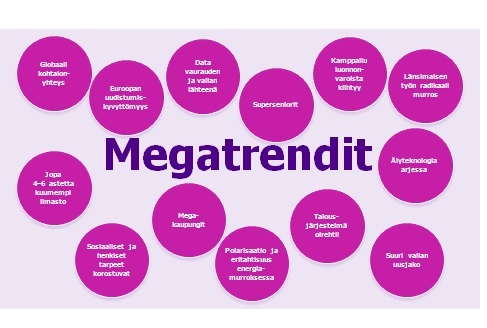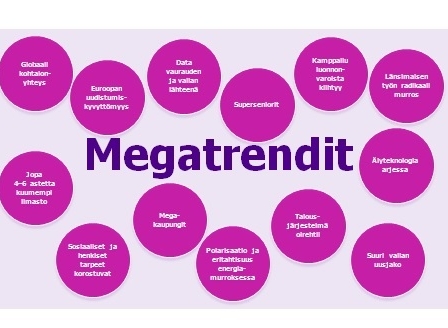The series of Sitra Trends articles looks at each of the topics on the Sitra Trend List, published in the autumn, one by one and from different points of view. This article is the first in the series.
Western work is going through a radical change. Industrial manufacturing is moving to cheaper countries, traditional jobs in these fields are disappearing, and Western countries are facing the question of how to create new jobs.
Furthermore, the situation in the southern European economies and the slowness of the painful structural changes have created a new generation of young unemployed people. For instance, the youth unemployment in Spain increased to a staggering 57 per cent in the spring of 2013. The question of whether growth will, in time, create new jobs, is a tricky one.
“The short-term challenge is that the rapidly accelerating technological change and the educational needs do not meet. In the USA, people already speak about the disappearance of middle-class, middle-competence jobs,” explains Sitra’s Senior Lead Teppo Turkki, who is currently studying the change in work and economy from the perspective of Asia and the global economy.
The digitalisation of work is very important. More and more basic work can be automated and handled by technology or robots. Brian Arthur, who has researched the digitalisation of economy, uses the term “Second Economy” when referring to this virtual economy. Its biggest impact is the substitution of low-productivity work, such as cashiers or airport officials, with machines. The new economy grows at a rapid rate, and according to Arthur’s calculations, in 2025 it will be as big as the physical economy was in 1995. The challenge the new economy faces is that it does not create jobs like the earlier economic growth drivers did.
“The jobs lost in the industry sector will not return to the West,” says Teppo Turkki. “They have mostly moved elsewhere, and when some of the production returns, the anticipated new jobs will be replaced by automation and brand new fields that require different kinds of skills. We will face a situation where entire middle-class professions will disappear with the entry of sophisticated technology.”
A good, though crude, example is the Instagram versus Kodak comparison. Kodak used to employ 140,000 people. Instagram, operating in the same field, employed a mere 14 people in 2012.
According to research by the New America Foundation, the number of average-income jobs is decreasing continuously, and they are being replaced by low-income jobs.
According to Turkki, the “middle-class workforce” as a professional and social class is disappearing. “Since 2009, 4.3 million new jobs have been created in the low-income fields in the countries which use the euro. At the same time, 7.9 million middle-class service and expert jobs have disappeared from the euro area. And they keep disappearing, with no new jobs to replace them,” he explains.
For example, 17 million Americans with a university degree are currently working in a job which does not require even a bachelor-level education. At the same time, the real salary level development (2011: 1.7 per cent growth) has stalled while the price of food and energy has increased (by 2.7 per cent). The Pew Research Center has also noted that one in three Americans raised in a middle-class family has dropped below the middle-class income level as an adult.
Even though research only covers the United States, the long economic crisis in Europe, the growing debt and the high youth unemployment rates give rise to a similar concern.
In Asia, on the other hand, the middle class is growing. In China especially, the number of middle-class and middle-income jobs is increasing steadily. At the same time, China is preparing for a labour shortage and cuts in the constantly growing labour costs by utilising automation and automated processes.
“In the East, we can see the birth of a big, new middle class, while at the same time it is nearing a crisis in the West,” Teppo Turkki points out.
Therefore, the challenge is whether or not the new profitable business created in the West can employ people or not. Have we really considered what this development means from the point of view of the distribution of wealth and social participation, for example? Where are these issues discussed, and is there enough courage to start solving these issues in the political arenas before it’s too late?
Who are the future experts?
The change is highlighted by the fact that more and more people are forced to invent a job and market it themselves. The amount of available information is completely different from in the past. It is possible to create entirely new global networks online, and these networks can be used to develop innovative ideas quickly. The change in the labour market alters the way we structure our lives and our work. Previously, one had to graduate and then find a job, whereas nowadays one can invent a job for oneself after graduation.
“The working life of the future can be described as fragmented, versatile and constantly changing,” says docent Anu Järvensivu, senior researcher at the Finnish Institute of Occupational Health. “This kind of an environment calls for new kinds of working life skills. On the other hand, we see counter-trends which involve new ways to operate. More and more people are becoming freelancers and private entrepreneurs, which has created new kinds of small businesses, working areas and networks.”
While traditional middle-level jobs in the West are changing, motivation, the combining of different skills, and the ability to co-operate are becoming more and more important in the Western working life.
“In Finland,” says Anu Järvensivu, “we still mainly operate in the spirit of the industrial era paid labour. However, working life has changed completely. Even though change always creates anxiety, you can still see a great opportunity in the change to get out of the yoke of paid labour and achieve a meaningful position, with more and more people starting small businesses and realising dreams.”
According to a research study conducted by Lynda Gratton, who has studied the new work for a long time, the working life of the future sees a division between passionate activist workers, and those who will be increasingly at the mercy of the turbulent global working life. The activists are reflective and passionate workers. They know who they are and what they want, and their work is characterised by meaningfulness and the will to change things, such as society. The activists work with enthusiasm, by learning and networking, and they are not at the mercy of individual employers. This way the activists get to choose different working communities, roles and projects.
“An activist attitude can be learned, too,” according to Anu Järvensivu. “One should remember that as late as the 1940s, a lot of work in Finland was done in the small entrepreneur spirit, and people managed just fine. I believe that a surprising number of people can still be working with an activist attitude. It is then important for different groups to find ways to co-operate and to express empathy towards one another. Maybe the activists can attract other people to join their ranks.”
Related material:
W. Brian Arthur: the Second Economy
The Economist, 27 April 2013: Generation jobless
Etla: Suuri Hämmennys – työ ja tuotanto digitaalisessa murroksessa
New America Foundation: The Middle Class Under Stress
New York Times, Thomas L. Friedman: Need a Job? Invent it!
PEW: Downward Mobility from the Middle Class Waking up from the American Dream



Recommended